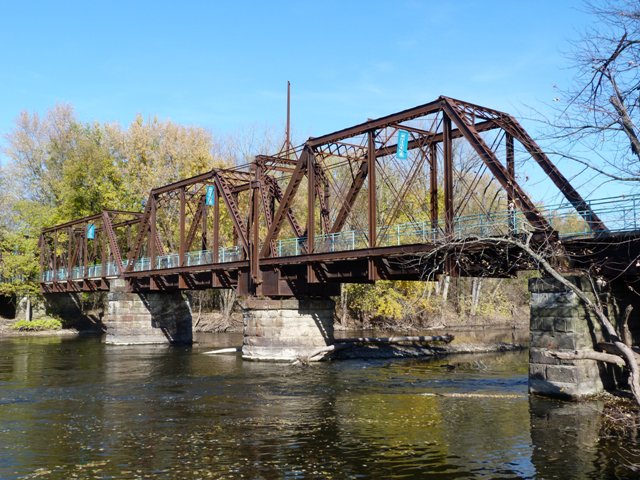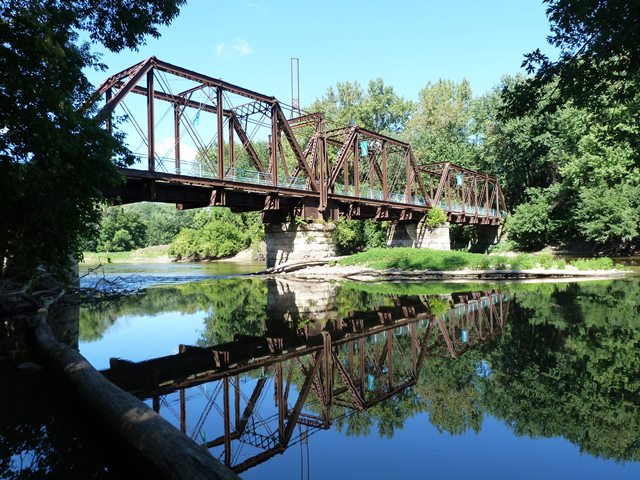We Recommend:
Bach Steel - Experts at historic truss bridge restoration.
BridgeHunter.com Phase 1 is released to the public! - Visit Now
Hopewell Indian Mounds Railroad Bridge
Lakeshore and Michigan Southern Railroad Bridge

Primary Photographer(s): Nathan Holth
Bridge Documented: 2006 - September 7, 2014
Walker and Wyoming: Kent County, Michigan: United States
Metal 8 Panel Pin-Connected Pratt Through Truss, Movable: Swing (Center Pier) and Approach Spans: Metal 6 Panel Pin-Connected Pratt Through Truss, Fixed
Not Available or Not Applicable
138.0 Feet (42.1 Meters)
550.0 Feet (167.6 Meters)
12 Feet (3.66 Meters)
1 Main Span(s) and 7 Approach Span(s)
Not Applicable

View Information About HSR Ratings
Bridge Documentation
This is a very old railroad swing bridge that replaced a movable wooden structure that dated to 1869. Some sources indicate that the existing bridge has an 1893 construction date. However, the stone piers of this bridge suggest a different possibility. Many of the stones of the substructure have graffiti from people carving useless junk into them over the years. However, one carving stuck out as something that might not be graffiti. A stone block on a northern pier appears to have been sculpted to produce a raised square section on the stone. Within this stone the text L H u D. OCT. 21 1894 is visible. This may be the initials of the stone mason and the date of their construction. However, the substructure would have to be the first part of the bridge built, so assuming this date is a real mark from the masons who built the pier (and not some unusual modern graffiti) the bridge would have to date to 1894, and perhaps not even completed until 1895. The unusual stone is shown below. To the left is the raised portion of stone with the writing in question. To the right is an example of typical graffiti markings on the stones.

This swing bridge ceased to swing in 1907 when boats stopped traveling the Grand River. The bridge carried trains up until 1975. The bridge was designed to carry a single set of tracks. Today the bridge has been converted for use as part of a rail-trail.
The existing bridge totals approximately 550 feet, and is composed of three 100 foot through truss spans, plus one 138 foot through truss swing span. A single deck plate girder span provides an approach at the southern end. The northern end has three short steel stringer spans supported by timber bents. Before the bridge was converted to a rail-trail bridge, a structurally independent 400 foot timber trestle structure provided a curved approach north of the bridge. Much of this wooden structure still stood in 2006, but was disconnected from the truss bridge, while the trail made a T intersection with another trail perpendicular to the bridge. By 2011, the 400 foot trestle was demolished and replaced with a modern timber trestle to carry an extension of the rail-trail. Following this rail-trail north from the bridge, more insight into the history of this railroad line is revealed. A short distance north of the bridge, the mainline continues to curve eastward, and at this curve, an old abandoned branch of the railroad line breaks off to head northward and crosses a small creek on a steel stringer structure supported by timber bents. The stringer bridge has United States Steel marks on it and bolted design suggested it may be from the mid-20th Century... certainly not as old as the swing bridge. The purpose of this old branch is unclear, and it is today extremely overgrown and the land where this branch would have gone is blocked by a large man-made hill, possibly part of a gravel pit. Meanwhile, the main railroad line, today the rail-trail, continues past the abandoned branch and also crosses the small creek on its own wooden structure.
The truss spans are all pin connected, and their many built-up beams are extensively latticed and v-laced. The swing span even features v-lacing on the top of the top chord and end post (instead of more common cover plate), and the fixed truss spans similarly feature lattice on the top of the top chord and end posts. Both of these characteristics are highly uncommon, in spite of the fact that the nearby Grand Rapids Swing Bridge has v-lacing on top of its top chord as well. One extremely unusual feature is the bottom chord of the fixed truss spans. The first couple panels of these spans have a bottom chord design that includes paired eyebars, but in a most unusual design, each eyebar is riveted to an angle. The two angles are connected by lattice. Riveting angles to eyebar is highly unusual, as is connecting the two eyebars with lattice.
This bridge remains in outstanding physical condition, especially the metal of the trusses which show little to no deterioration.
Unlike most historic bridges on rail-trails, there actually is some interpretive signage discussing this bridge, which is nice to see. Less impressive is the ugly cyclone fencing that was placed to function as a railing on the bridge. It would be nice to see this replaced with a metal railing of more dignified appearance that additionally does not visually obstruct the view of the bridge's trusses in the way that the cyclone fencing does.
This bridge is tagged with the following special condition(s): Unorganized Photos
![]()
Photo Galleries and Videos: Hopewell Indian Mounds Railroad Bridge
Structure Overview
Original / Full Size PhotosA collection of overview photos that show the bridge as a whole and general areas of the bridge. This gallery offers photos in the highest available resolution and file size in a touch-friendly popup viewer.
Alternatively, Browse Without Using Viewer
![]()
Structure Details
Original / Full Size PhotosA collection of detail photos that document the parts, construction, and condition of the bridge. This gallery offers photos in the highest available resolution and file size in a touch-friendly popup viewer.
Alternatively, Browse Without Using Viewer
![]()
Structure Overview
Mobile Optimized PhotosA collection of overview photos that show the bridge as a whole and general areas of the bridge. This gallery features data-friendly, fast-loading photos in a touch-friendly popup viewer.
Alternatively, Browse Without Using Viewer
![]()
Structure Details
Mobile Optimized PhotosA collection of detail photos that document the parts, construction, and condition of the bridge. This gallery features data-friendly, fast-loading photos in a touch-friendly popup viewer.
Alternatively, Browse Without Using Viewer
![]()
Additional Unorganized Photos
Original / Full Size PhotosA supplemental collection of photos that are from additional visit(s) to the bridge and have not been organized or captioned. This gallery offers photos in the highest available resolution and file size in a touch-friendly popup viewer.
Alternatively, Browse Without Using Viewer
![]()
Additional Unorganized Photos
Mobile Optimized PhotosA supplemental collection of photos that are from additional visit(s) to the bridge and have not been organized or captioned. This gallery features data-friendly, fast-loading photos in a touch-friendly popup viewer.
Alternatively, Browse Without Using Viewer
![]()
Maps and Links: Hopewell Indian Mounds Railroad Bridge
Coordinates (Latitude, Longitude):
Search For Additional Bridge Listings:
Bridgehunter.com: View listed bridges within 0.5 miles (0.8 kilometers) of this bridge.
Bridgehunter.com: View listed bridges within 10 miles (16 kilometers) of this bridge.
Additional Maps:
Google Streetview (If Available)
GeoHack (Additional Links and Coordinates)
Apple Maps (Via DuckDuckGo Search)
Apple Maps (Apple devices only)
Android: Open Location In Your Map or GPS App
Flickr Gallery (Find Nearby Photos)
Wikimedia Commons (Find Nearby Photos)
Directions Via Sygic For Android
Directions Via Sygic For iOS and Android Dolphin Browser
USGS National Map (United States Only)
Historical USGS Topo Maps (United States Only)
Historic Aerials (United States Only)
CalTopo Maps (United States Only)



